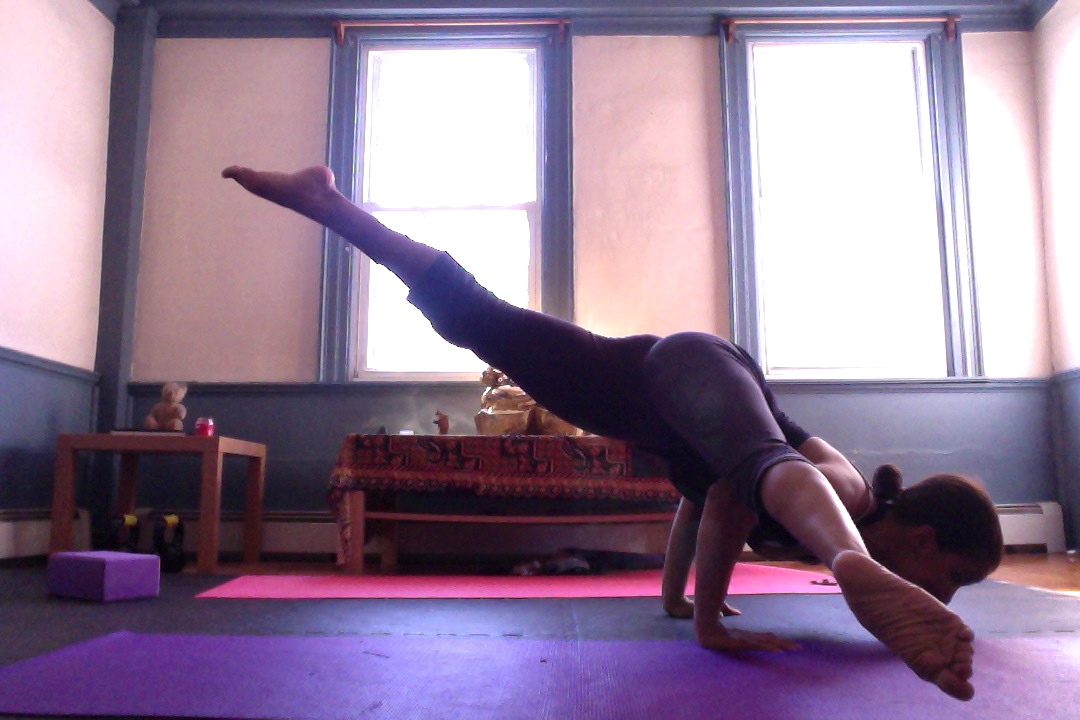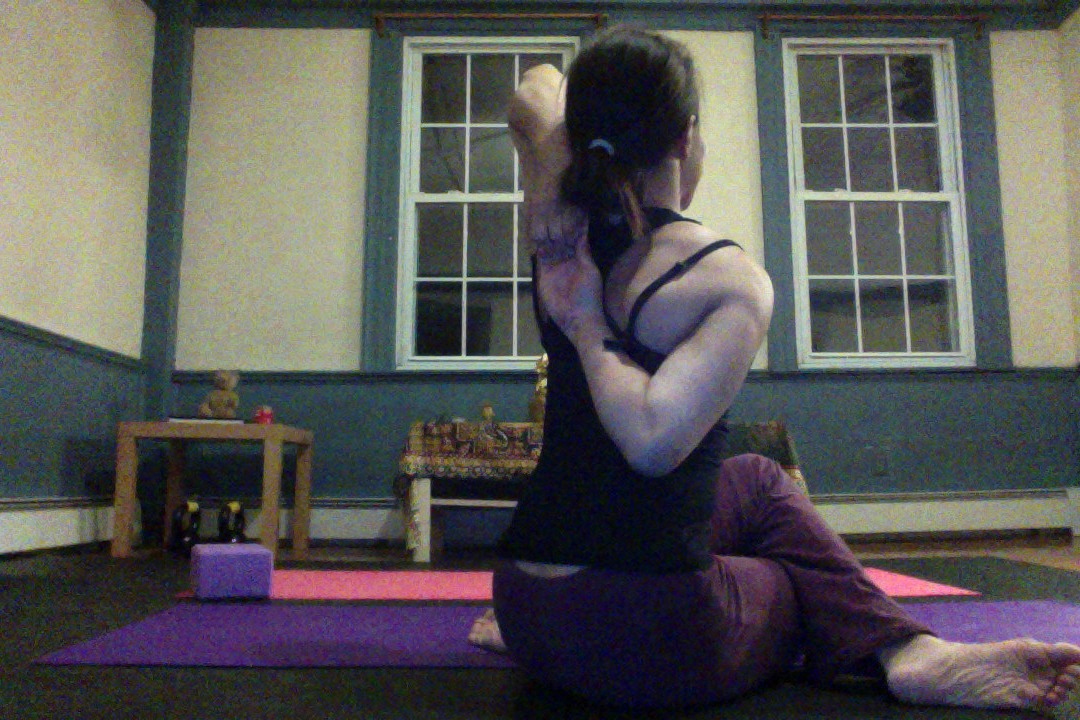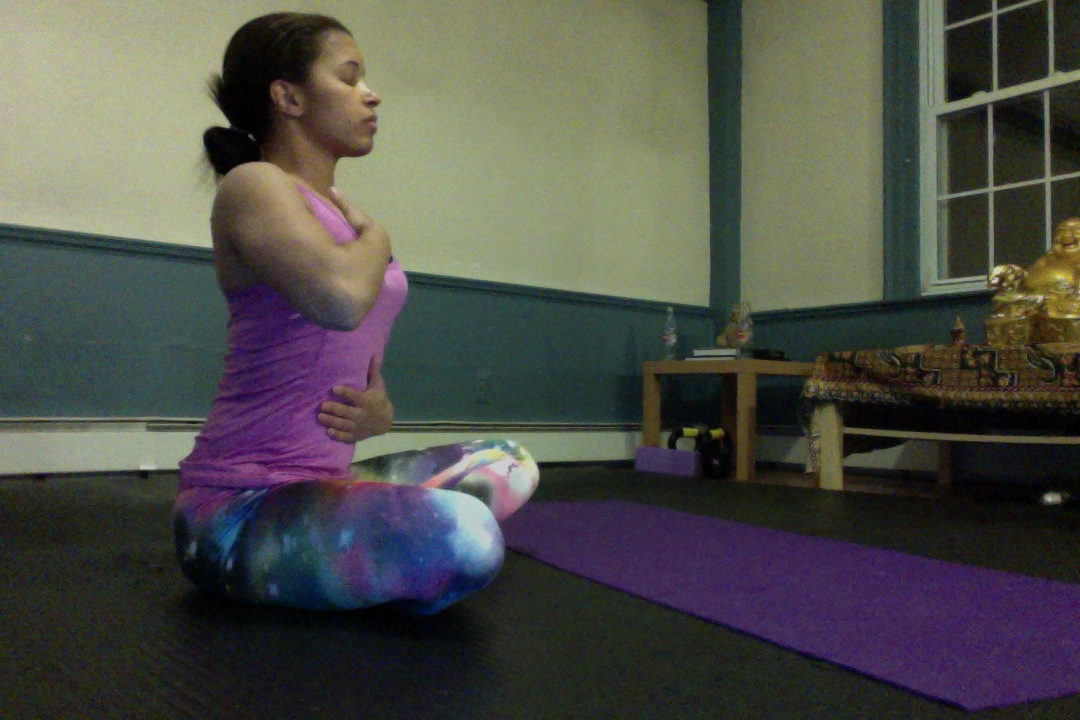
Vrksasana, or Tree Pose
Toward the end of 2013, I was looking for more tools to not only help me serve clients as a health coach, but to also become a part of my own healing regimen. I had studied and become certified as a holistic health coach, specializing in nutrition at IIN. I had studied as a women’s fitness specialist with NASM. I had even taking the first steps toward getting certified to teach various mind-body modalities that continued to help me and that I wanted to help teach and coach others in so that they could see the positive, healing effects from it as well. And then, I came across Lim Yoga.
But first, a little history: Yoga has interested me for many years, as a more health-focused approach to the skills and movements I first learned as a gymnast when I was a child. However, there were years where I was very limited in what I could do and how often I could do it, due to the autoimmune disease’s extreme chronic pain of the nerves and muscles, stiffness of the muscles and bones, and post-exercise malaise that just compounded the severe fatigue I felt daily. When I began to build my strength and endurance back again a couple years ago, to the point where I felt my healthiest in more than a decade, yoga began to really call to me again.
I began simply enough. I started doing the poses I knew, working along to Gaiam TV’s instruction yoga show Namaste Yoga, as I had done with my mother years prior, whenever I could muster the will and enough energy. I loved Canadian Kate Potter’s athleticism, strength and graceful flexibility.
Meeting Yoga Challenges With My Health Challenges
And then, I discovered Instagram. When you are curious enough, technology can be the most incredible tool and resource. Through this app, I found the most amazing yoga teachers/yoginis, not just across the United States, but also in different areas of the world. Some had their private practice that they shared with their followers—some of the most amazing athletes I’ve ever seen inspire and humble me daily. Perhaps even more fun to me, there were practitioners who got together to lead monthly challenges, which often featured poses that built on previous ones as the days of the month passed by. About two years ago, I began embarking on several yoga challenges each month.
Living with unpredictable autoimmune disease and then, with the even more unpredictable movement disorder called dystonia, there were days when I had to skip yoga challenges. There were days when I felt fantastic and could catch up on four or five days’ worth of several challenges. I tried everything! As a recovering athlete, I especially loved poses that relied heavily on body strength, but I soon learned to really enjoy challenging and improving my balance and flexibility as well.
Over time, as I felt my body once again becoming more limber, balanced and strong in new ways, I allowed the little seed of a dream to bloom into the full-fledged goal to one day teach yoga.
Unfortunately, when you have something like dystonia, there are some days you cannot stand up without falling down, much less try to hold a yoga pose for longer than a couple breaths. During these times, trying to invert the body inevitably will lead to falling—fortunately, gymnastics taught me to be an excellent roller when I fall. When the body is already contorting without abandon, twisting poses like Half Lord of the Fishes Pose and Bharadvaja’s Twist can actually cause more contraction of the muscles for a longer period of time and thus, increase pain and muscle fatigue.
Yet, there are many poses—like upward salute, downward dog, tree pose and mermaid—that ground me, even when I may be having trouble with balance or strength.
Finding Control on the Yoga Mat
There are days when I feel like it is only on the yoga mat where I have any control of my muscles at all. Off the mat, I have no control if my head twists to the left, if my mouth contorts, if my legs start dancing, if the muscles around my ribs and hips start twisting horizontally or my arms curl up into fists. On the yoga mat, I am purposefully placing my body in certain poses. If I am moving my body into the full body stretch and more gentle twist of Gomukhasana, I am doing so for a specific reason. When I release the pose, I control when and how I untwist, breathing with control. When I am move to put my weight on a leg, I am controlling the shift in balance, not some unknown force.
There are days when that control is missing completely. But the days where I can help steer, they give me hope and joy for that day, no matter how short (or long) my time on the mat may be.
Toward the end of last year, I was surfing Google, looking for information on yoga and movement disorders. I wanted to learn more about which poses were specifically contraindicated to this misfire of the central nervous system. My massage therapist had felt unease doing cranio-sacral release after my diagnosis of dystonia, worrying she could be causing more damage. My neurologist and my boyfriend both had expressed concerns that there was a link between certain intense workout sessions and increased irregular muscle movements and the clenches and freezes. I was signed up for a training course specifically for tai chi and movement disorders—surely someone must have done research into yoga and movement disorders as well.
And then I came across Lim Yoga: Yoga for Parkinson’s and Movement Disorders with Renée Le Verrier (great name, by the way). Just looking at her website gave me hope. I put her book, Yoga for Movement Disorders, and its accompanying DVD on my Amazon wish list. At Christmas, I was extremely excited to find it in my hands after some unwrapping.
Coming Back to Center With Yoga
It wasn’t until this past week, however, that I finally began reading it. I didn’t realize that La Verrier was actually teaching from personal experience. Not only does she have Parkinson’s, she has lived most of her life with partially lost mobility after a very early stroke. As I read about her diagnosis, prognosis and yoga journey, I immediately felt a kindred spirit. While we had differences in our stories, we experienced very similar things from yoga.
Living with a movement disorder, you can become very self-conscious about your body, especially in front of others. You may judge yourself because your body won’t listen to what your mind is begging it to do. As a result, there is often an unhealthy relationship between the two. Yoga doesn’t stand for this. Yoga engenders compassion toward your body.
“I was learning to rest comfortably in the present, instead of worrying about the past or fretting about the future,” La Verrier writes about her beginning experiences with yoga. “Any body, I discovered, even one with Parkinson’s, can find that calm abiding place.”
In this centering place, she and I both find that we are in a state of sadness over losses due to disease with the past is behind us and we’re not worried or fearful of degeneration or new symptoms popping up in the future, because we are right here, right now on that mat.
Becoming more comfortable in your own skin again is one of the greatest gifts yoga can give to someone with a movement disorders. It not only physically strengthens you, helping to regain balance and some flexibility—it also builds inner strength. It helps you keep a calmer and more stable center. Bringing awareness to your body can help identify the sources of tightness, tension and spasm—breath can help us release.
Perhaps, right now, this is a rough hour (or couple hours or days), but I will ride it through, because I know better hours are ahead.
With Unpredictable Movement Disorders, Yoga Meets You Wherever You Are
La Verrier’s words are so encouraging, reinforcing what I know at the core to be true—that it’s totally okay to begin practice wherever you may be at the moment. Just because you can’t do an arm balance—or even stand on your legs one day—does not mean you cannot gain the benefits of yoga.
“Adjust your yoga practice for where you are that day, even if that starting point bears no resemblance to yesterday’s starting point,” writes La Verrier. “Your body’s cues tell you when to modify a pose are try a variation.”
Pain, strained breath and fear of falling or some cues that signal when you should try variations. There are so many modifications—allowing you to do poses seated instead of standing, using props to relieve pressure or restore balance when your body is jolted out of alignment from spasms or muscle stiffness, using light weights of sandbags or rice sacks to help calm tremors and uncurl tight arms.
These modifications offer the benefits of strengthening and stretching without worry of falling or overdoing it, causing harm. Just a few moments in seated tadasana, or mountain pose—which guides body alignment and a more balanced gait—has lasting, energizing effects, La Verrier points out.
If you can’t do an hour-long practice, do 15 minutes. If you can’t stand, then sit. If you can’t do a forward fold, or bend, with straight legs, then gently bend your knees, with your quads engaged. If “all you can do” is focus on your breath, you are bringing attention and awareness to your body in a wholly different way then when you are simply reacting to symptoms. With each inhale and exhale, you are drawing in more air, releasing and relaxing tension in both the body and the mind.
La Verrier’s Lim Yoga is an excellent reminder for hindered athletes like me that you can be doing excellent things for your body without doing crazy acrobatics that will draw accolades (even if you’re just seeking your own). It is also reassuring for those of us, when bedbound and feeling completely overwhelmed by what we can’t do due to our cyclone of symptoms, to know there are simple movements we can do that have very positive and beneficial effects on both our body and spirit.




Hope is so important when you are facing any physical challenge. Your story is very inspiring.
Thank you so much. Yes, even a flicker of hope really can flip your perspective and thus you health around so dramatically!
Thanks so much, and I appreciate your kind words!
I have dystonia as well
And just joined a yoga studio. I had much difficulty with balance poses, but so thankful I joined to help sustain inner peace. Stress is a huge trigger for my dystonia, so I’m hoping just being in the moment at the time will help and eventually carry over go everyday life. Namaste.
Sherry, I’m so glad you’ve found yoga to help you find peace with dystonia as well. I believe as you keep integrating yoga and deep breathing into your life, you will be able to better manage the stress trigger too. Keep me updated! Namasté